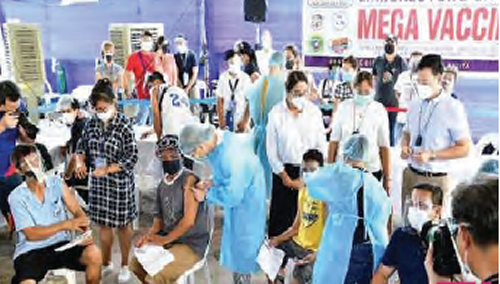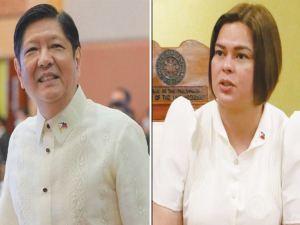The Philippines has administered 15.6 million doses against the COVID-19 virus.
Harry Roque, spokesperson of President Rodrigo Duterte, shared this number in a media briefing Wednesday (July 21).
Of the 15.6 million does administered by the government, Roque said 10,585,261 million persons got their first dose.
As well, 5,031,301 people received their second shot as of July 20.
The government’s daily vaccination rate has so reached more than 280,000.
Roque encouraged anew Filipinos to get vaccinated as soon as possible to enhance their protection against the virus especially amid the threat of the new Delta variant.
Roque assured the public that the coronavirus vaccines currently available in the country are effective even with the Delta threat.
The government meantime is hopeful the country’s vaccination rate will steadily rise as more vaccine supplies will be delivered to the country.
Roque said that around 562,779 Pfizer jabs procured by the government are expected to arrive in the country on July 21.
Additional 1.5 million doses of Sinovac vaccines will be delivered on July 22, and another 1 million of Chinese-made jabs on July 23.
As of July 21, the Philippines has a vaccine stock of 27,922,360 doses, including 12.4 million donations from COVAX facility, Japan, and China.
The government aims to vaccinate the bulk of the country’s populace to reach population protection and later herd immunity.
“Magpalista na po tayo, makipag-ugnayan sa inyong LGU tungkol sa inyong pagpalista. Dagdag proteksyon sa inyo, sa inyong pamilya, at sa inyong komunidad,” Roque said.
(Register and coordinate with your LGU regarding your vaccination. This will be your protection, for your family and community.)
Infectious disease expert Dr. Rontgene Solante, meanwhile, encouraged the public to get vaccinated amid the threat of the highly infectious Delta variant.
Solante explained that a fully vaccinated individual has a lower risk of getting the infection or developing severe symptoms of COVID-19.
“For fully vaccinated individuals, the risk is really low compared to unvaccinated. And in fact, there’s data that has been gathered in countries wherein a surge is being documented, and most of those cases are those cases that are not vaccinated,” Solante said.
The Philippines has the second-highest COVID-19 tally in Southeast Asia, with over 1.5 million coronavirus cases.
The government aims to vaccinate 58 million to 70 million of the 109 million population this year to safely reopen the economy, which suffered its worst postwar slump last year due to the COVID-19 crisis.
Authorities are on guard against more infectious COVID-19 variants, especially the Delta strain, that could lead to a surge in cases.
The emergence of local cases of the more transmissible Delta variant of COVID-19 in the country should not change the ultimate target of vaccinating 70 percent of the population by the end of the year, Solante said.
“The presence of the Delta variant is not really a big factor [to make changes on the target]. We should still have the same target of vaccinating 70 percent of our population by the end of the year, especially those in high-risk populations,” the vaccine expert said.
Also, Malacañang on July 21 assured residents in areas under enhanced community quarantine (ECQ) due to spikes in COVID-19 cases of cash aid.
“To residents of Iloilo province, Iloilo City, Cagayan de Oro, Gingoog, you are not forgotten by the President,” Roque said in a press briefing.
“The government will provide cash assistance and I think it will not be lower than what residents of Metro Manila received the last time Metro Manila was in ECQ,” he added.
The government placed Iloilo province, Iloilo City, Cagayan de Oro and Gingoog, Misamis Oriental under ECQ until July 31.
Roque said the Inter-Agency Task Force for the Management of Emerging Infectious Diseases (IATF-EID) is yet to decide on the amount of the financial aid.
Roque also said, “From the beginning, the President has been telling the IATF-EID he will not let the government impose ECQ without providing cash aid to those who cannot work because of the lockdown. The amount is yet to be decided but that has been the policy of the President for so long.”








